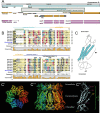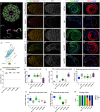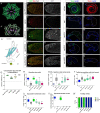Gap junctions mediate discrete regulatory steps during fly spermatogenesis
- PMID: 36174062
- PMCID: PMC9578636
- DOI: 10.1371/journal.pgen.1010417
Gap junctions mediate discrete regulatory steps during fly spermatogenesis
Abstract
Gametogenesis requires coordinated signaling between germ cells and somatic cells. We previously showed that Gap junction (GJ)-mediated soma-germline communication is essential for fly spermatogenesis. Specifically, the GJ protein Innexin4/Zero population growth (Zpg) is necessary for somatic and germline stem cell maintenance and differentiation. It remains unknown how GJ-mediated signals regulate spermatogenesis or whether the function of these signals is restricted to the earliest stages of spermatogenesis. Here we carried out comprehensive structure/function analysis of Zpg using insights obtained from the protein structure of innexins to design mutations aimed at selectively perturbing different regulatory regions as well as the channel pore of Zpg. We identify the roles of various regulatory sites in Zpg in the assembly and maintenance of GJs at the plasma membrane. Moreover, mutations designed to selectively disrupt, based on size and charge, the passage of cargos through the Zpg channel pore, blocked different stages of spermatogenesis. Mutations were identified that progressed through early germline and soma development, but exhibited defects in entry to meiosis or sperm individualisation, resulting in reduced fertility or sterility. Our work shows that specific signals that pass through GJs regulate the transition between different stages of gametogenesis.
Conflict of interest statement
The authors have declared that no competing interests exist.
Figures








References
Publication types
MeSH terms
Substances
Grants and funding
LinkOut - more resources
Full Text Sources
Miscellaneous

